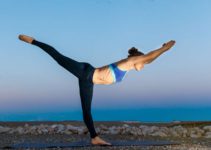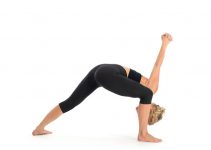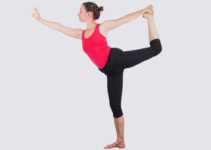
Are you ready to take your yoga journey to a whole new level by challenging your strength and flexibility? If so, trying Astavakrasana will be the best option for you right now.
Astavakrasana is assumed by lifting the entire body off the floor with both the legs extended to one side. This asymmetrical posture is an advanced-level practice as the body is balanced only on the arms.
This pose is performed in a sitting position involving side-bend, balancing, and twisting of the body. Therefore, this posture is known for its strengthening benefits and brings stability within the body.
Astavakrasana Meaning
Astavakrasana is a name derived from the Sanskrit language whose meaning can be defined by breaking it down into the three root terms:
- “Asta” means “eight”
- “Vakra” refers to “bent” or “curved”
- “Asana” is “posture”
Astavakrasana pose is attained by bending the body in eight different regions or angles; one in the chest, one in the neck, one in each hand, each foot, and each knee, hence the name. The pose is also known as the Eight Angle Pose.
Story of Astavakrasana
According to Hindu mythology, there was a sage who was the spiritual guru of King Janak of Mithila. When the sage was inside her mother’s womb, he learned all about the Vedas from his father.
One day his father, Kahoda was reciting Vedas and attempted several mistakes in doing so. To his mistakes, the unborn sage couldn’t help but laugh. This outraged his father which led him to curse his son that he would take birth with a body crippled in eight regions.
Thus, when he took birth he had a twisted body around the chest, neck, feet, hands, and knees. For this, he was named Astavakra. This posture is also attained by bending the body in the same way as his body, thus it is named after him.
Sage Astavakra had a crippled body but he led a successful spiritual life and guided King Janaka during his reign. His life is a perfect example that physical disability can be overlooked if you have a strong will and soul.
Astavakrasana despite being a challenging posture provides similar benefits to the practitioner by engaging the soul to achieve mental stability. This pose also allows the yogi to appreciate his\her inner strength.
Astavakarasana Practice Guide
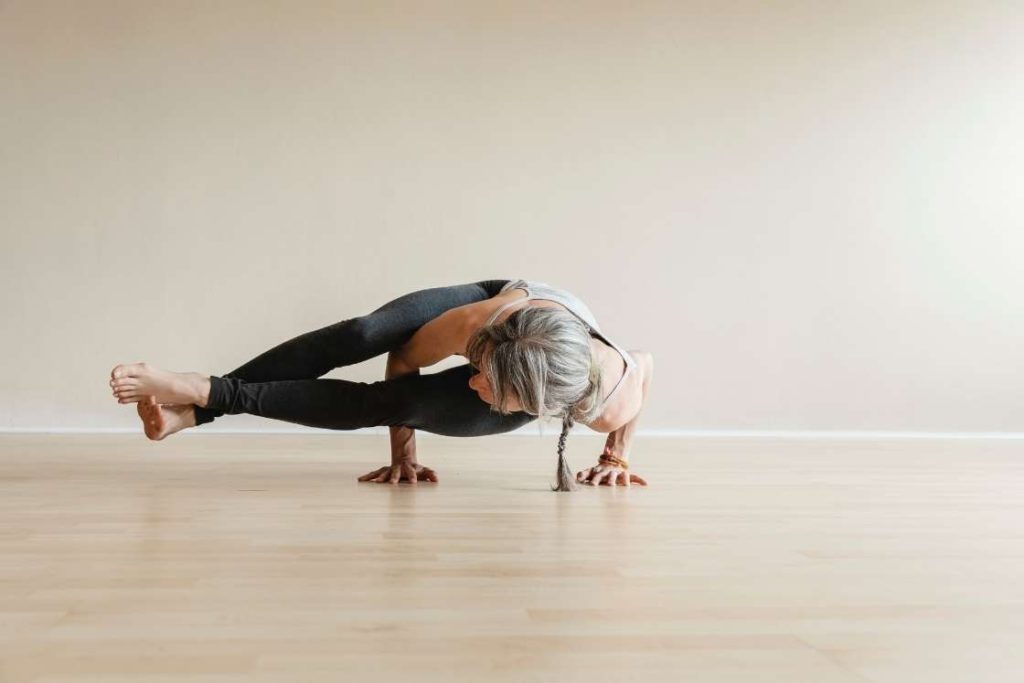
Contraindications
- Avoid the posture if you have an injury around your shoulders, wrists, elbows, or any other joints in the body.
- Do not try astavakrasana with back pain, slipped disc, or any spinal issues.
- People with carpal tunnel syndrome must not attempt this asana.
- Women during pregnancy must not try it.
- It should not be practiced with an injury or surgery in the legs, hips, lower back, and pelvis.
- Patients with cardiac diseases, high blood pressure, and vertigo must skip this pose.
Preparatory poses
To perform astavakrasana like arm-balancing posture, the strength of the hip flexors, upper body, hamstrings needs to be furnished. Therefore, these given preparatory poses must be practiced before astavakrsana:
- Standing Forward Bend (Uttanasana)
- Pigeon Pose (Kapotasana)
- Four-Limbed Staff Pose (Chaturanga Dandasana)
- Bound Angle Pose (Baddha Konasana)
- Extended Side Angle Pose (Utthita Parsvakonasana)
- Standing Figure Four Pose (Eka Pada Utkatasana)
- Seated Wide-Angle Forward Bend (Upavistha Konasana)
How to Do Astavakrasana (Steps)
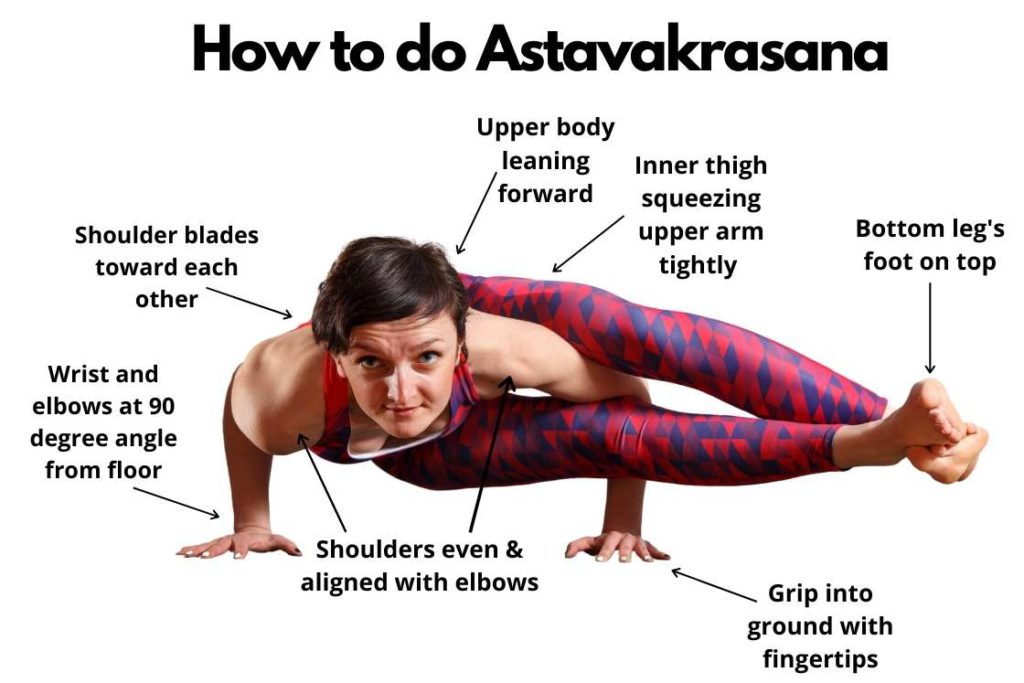
Follow step-by-step procedure below to jump into Astavakrasana.
- Begin with sitting in dandasana
- Bent the right leg on the knee and grab the right foot with the left hand and bring the right arm on the inside of the right thigh.
- Holding the right foot with the left hand extend the right leg up so that the right thigh rests on the upper shoulders of the right arm.
- Firm the right palm on the floor beside the right hip.
- Hook the right knee with the right arm and press both the palms on the floor to lift the hips and legs off the floor.
- Bend your left knee to hook the left ankle with the right and extend both the legs towards the right.
- Simultaneously, shift your chest and weight forward bending the arms at the elbows and shoulders are kept square.
- Finally, the upper body is parallel to the floor, hips are twisted and elevated to keep the legs balanced.
- Exhale, look forward and stay balanced in the pose for 30-60 seconds breathing deeply.
- Straighten the arms and trunk to bring the legs forward, release the ankles, and relax in dandasana.
- Repeat the same steps for the left side.
Follow-up poses
- Shoulder pressing posture (Bhujapidasana)
- Two Legs Over Arms Pose (Dwi Pada Bhujasana)
Precautions
No matter which poses you are practicing safety comes first to harness only benefits and to eliminate the possible threats.
Therefore, keep the following points in mind while practicing astavakrasana:
- Ensure that you enough hip flexibility, core strength, and balance in the body before attempting the pose.
- In the final position of astavakrasana, for better balance, do not look down to the floor instead gaze forward.
- In the beginning, hold the pose for only 2-3 deep breaths and gradually increase the time.
- Be mindful while releasing the pose, do not rush to unlock the ankles to avoid any jerk on the legs.
Props and Modifications
- Yoga blocks – Take two yoga blocks and place each of them beside both the hips. Press both your palms on the blocks instead of pressing them to the floor. It eases the pose while lifting the legs.
- Bolster – To balance in this posture easily especially in the beginning place a bolster under the lower leg. Hence when you are extending the legs towards the right, the left hip and leg rest on the bolster.
Astavakrasana Variations
There is an advanced version of astavakrasana in which the body is bent in the same way, except the arms.
- In this variation, the hand between the legs remains pressed against the floor, however, one forearm the alternate arms are laid on the ground.
- The body is balanced on one hand and one arm bent at the elbow.
- After finding the proper balance lift the arm at the elbow to place the hand under the chin.
- In the final pose, the bent and twisted body is balanced on one hand and one elbow.
Astavakrasana Benefits
1. Strengthen the lower body – Astavakrasana stretches the hips and entire leg muscles starting from the gluteus to the ankles. The pelvic floor muscles are also stimulated. It tones the inner thighs and strengthens the legs.
2. Improves arm strength – The weight of the body is balanced on both arms. It stretches the shoulders, elbows, wrists, contracts the biceps and triceps. Thus, improves the strength of the arms.
3. Builds endurance – Lifting the legs off the floor and extending them towards a side uses the core strength. This move and balancing the body against gravity pushes the limits and capacity of the body, hence promotes overall endurance.
4. Tones the abdominal muscles – The abdominal muscles are also stretched and the internal organs are massaged. It improves the flow of blood to this region and tones the abdomen.
5. Stimulates energy chakras – Astavakrasana stimulates Manipura and Swadhisthana chakra. The activation of these chakras helps promote confidence and creative skills. It energizes the body and enhances living standards.
7. Enhances the reproductive system – This pose stretches the pelvic floor muscles and improves the blood circulation in this region. Also, the activation of sacral chakra improves sexual health thereby facilitating the efficiency of the reproductive system.
8. Psychological benefits – Balancing the body in astavakrasana improves the focus of the practitioner. It stabilizes the mind and supplies oxygen to the brain to provide clarity. Hence, this pose serves as a stress reliever too.
Conclusion
Strengthen your inner-self to set yourself free from all limitations that you have put forth just because it seems tough.
To gain such a sense of self-achievement, astavakrasana is the best possible yogic way out there.
